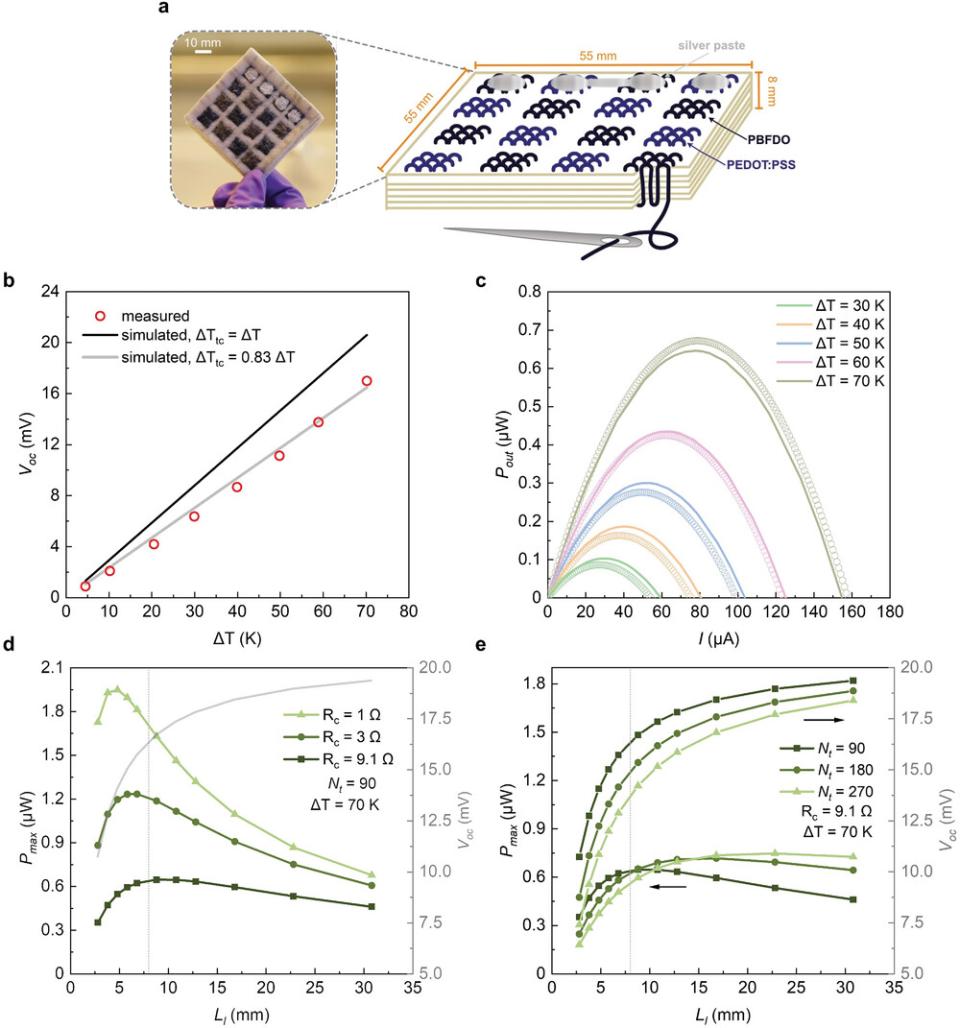- Ученые из Швеции разработали термоэлектрический текстиль, который может питать устройства без использования батарей.
- Термоэлектрический текстиль преобразует разницу температур в электрический потенциал.
- Технология может использоваться для мониторинга движений и измерения сердцебиения человека.
- Материалы для термоэлектрического текстиля должны отвечать высоким требованиям безопасности и гибкости.
- Шелковая нить, покрытая проводящим полимером, была использована в исследовании.
- Новый тип нити обладает исключительной стабильностью и хорошей способностью проводить электричество.
- Термоэлектрический текстиль сохраняет свои свойства после стирки и может быть изготовлен автоматизированным процессом.
- Исследование может принести большую пользу обществу и открыть фантастические возможности для термоэлектрического текстиля.
 Performance of the thermoelectric generator composed of eight thermocouples. a) Schematic and photograph of the thermoelectric generator. b) Open-circuit voltage Voc as a function of ∆T (circles represent experimental values; black and grey lines calculated assuming that ΔTtc = ΔT and ΔTtc = 0.83 · ΔT, respectively); c) output power Pout of the thermopile as a function of current I for different temperature differences ΔT (circles represent experimental values, lines represent the results from the simulation at different ΔT considering a thermal contact resistance of 97 K cm2 W−1). d) Predicted Pmax (right) and Voc (left) generated from the thermoelectric generator at ΔT = 70 K and thermal contact resistance of 97 K cm2 W−1 as a function of thermoelectric leg length (Ll) (vertical grey line at Ll = 8 mm represents the actual Ll of the device). The electrical contact resistance Rc per thermocouple was 1 Ω (triangles), 3 Ω (circles), 9.1 Ω (squares) (which corresponds to the actual Rc of the device at ΔT = 70 K), and the thread count Nt was set to be 90. e) Predicted Pmax (right) and Voc (left) generated from the thermoelectric generator at ΔT = 70 K and thermal contact resistance of 97 K cm2 W−1 as a function of Ll (vertical grey line at Ll = 8 mm represents the actual Ll of the device). The electrical contact resistance Rc per thermocouple was 9.1 Ω (which corresponds to the actual Rc of the device at ΔT = 70 K), and the thread count Nt was 90 (squares), 180 (circles) and 270 (triangles).
Performance of the thermoelectric generator composed of eight thermocouples. a) Schematic and photograph of the thermoelectric generator. b) Open-circuit voltage Voc as a function of ∆T (circles represent experimental values; black and grey lines calculated assuming that ΔTtc = ΔT and ΔTtc = 0.83 · ΔT, respectively); c) output power Pout of the thermopile as a function of current I for different temperature differences ΔT (circles represent experimental values, lines represent the results from the simulation at different ΔT considering a thermal contact resistance of 97 K cm2 W−1). d) Predicted Pmax (right) and Voc (left) generated from the thermoelectric generator at ΔT = 70 K and thermal contact resistance of 97 K cm2 W−1 as a function of thermoelectric leg length (Ll) (vertical grey line at Ll = 8 mm represents the actual Ll of the device). The electrical contact resistance Rc per thermocouple was 1 Ω (triangles), 3 Ω (circles), 9.1 Ω (squares) (which corresponds to the actual Rc of the device at ΔT = 70 K), and the thread count Nt was set to be 90. e) Predicted Pmax (right) and Voc (left) generated from the thermoelectric generator at ΔT = 70 K and thermal contact resistance of 97 K cm2 W−1 as a function of Ll (vertical grey line at Ll = 8 mm represents the actual Ll of the device). The electrical contact resistance Rc per thermocouple was 9.1 Ω (which corresponds to the actual Rc of the device at ΔT = 70 K), and the thread count Nt was 90 (squares), 180 (circles) and 270 (triangles).
